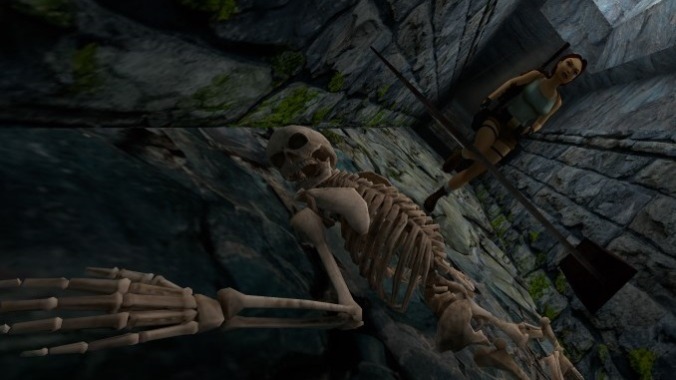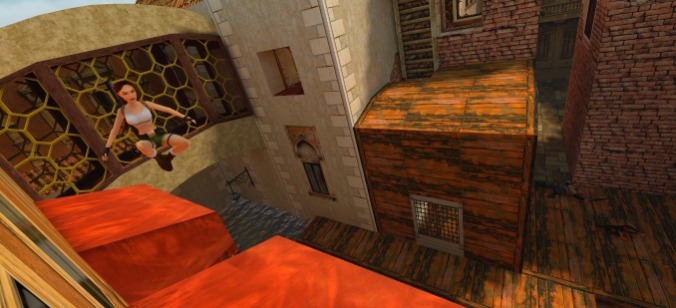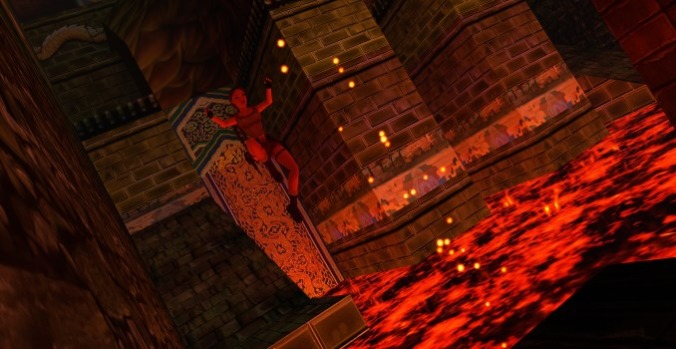Tomb Raider Is For Squares: How Grids Defined the Original Classic
Lara Croft: "Tank” Girl
Games Features Tomb Raider
The original Tomb Raider was constructed atop an interconnected series of grids.
“Our whole system was based around these blocks,” said creator Toby Gard in The Angel of Darkness Companion. “And the fact that Lara was basically three-quarters of a block high in height, and she could directly jump and grab hold with her fingers a block and a half. Everything, whole levels, were built with this very simplistic blocky form.”
Level designer Heather Gibson—who also designed a majority of the textures—worked with Gavin Rummery’s in-house Room Editor to design setpieces corresponding to Lara Croft’s range of movement. Each square is roughly equidistant to a full stride step; paces take up around a quarter to half a square.
“We knew she could do a run and grab jump over four blocks distance,” Gard further explained, “but you could also do one at an angle, if it was four blocks distance but the one you’re jumping to is a quarter of a block lower. So it was very easy for the level artists, once they had an understanding of what her abilities were, to stick in as much to challenge her as they could.”
Every level in the “classic” Tomb Raider games—that would be the 1996 original to 2000’s Chronicles—is designed around this philosophy. 2003’s heavily criticized Angel of Darkness was an ambitious half-step between these “tank controls” and then-contemporary 3D adventure norms. It wasn’t until 2006’s Crystal Dynamics reboot, Tomb Raider Legend, that Lara would find her foothold on the modern face of gaming.
When playing Tomb Raider I-III Remastered (released this past February by Aspyr), it’s tempting to default to the updated control scheme included with the release. They offer full camera control, and also give Lara access to a smooth 360 degree radial axis of movement. However, in using these controls, I found that they undermine and ultimately sully the artistry of the original.
Worse? They’re not fun.
There is a certain je ne ce quoi to trusting Lara’s tank controls to navigate Core Design’s devious grids. It’s true, she’s a bit rigid and stuck in her ways. She won’t grab onto ledges without direct input, strafing is only possible at a crawl, and she can’t fall more than a few squares without dying. (Don’t even get me started on that camera.) Players accustomed to automation might find her off-putting, but after a few levels, her reliability is next to none. It’s the difference between an automatic and manual clutch.
“Most games defined where the player could go and what they could interact with, using cheats like invisible walls and false ledges,” said former studio manager Gavin Rummery in the 2016 book, 20 Years of Tomb Raider. “But in Tomb Raider, Lara called the shots. If she could grab a ledge then she could climb up there, and we designed the levels around her abilities.”

By The Floating Islands at the end of Tomb Raider II—a frightening, vertigo-inducing level if there ever was one—there’s a very careful methodology players have hopefully learned to adopt by that point. Gibson’s driving impetus in these classic games was to create vertical levels players had to explore their way up; in Tomb Raider II, it could be argued she and the team hit the logical extent of that innovative philosophy.
The reliability of Lara is what made this design possible. Even hundreds of feet above ground, leaping between suspended land masses is less scary with a reliable and comprehensible way to measure each jump. Tomb Raider is, at its core, about presenting seemingly impossible tasks to players and trusting them to figure it out.
When all else fails? Trial and error takes over.
“Ideally, the player should be able to negotiate a trap or jump on the first attempt after analyzing the area,” said Gibson in 20 Years. “However that didn’t always turn out to be the case and sometimes a player would die before they could figure out how to complete the challenge.”
Ultimately, progression in classic Tomb Raider is built around estimates and measurements. Those measurements are—of course—accounted for in the aforementioned squares. A limitation of early 3D graphics became the de facto method of level design for the first batch of Tomb Raider games. While Tomb Raider II and III make clear attempts to break outside of that rigidity with underwater maps and selective progression, each platforming sequence ultimately cuts right back down to the blocks. Whether Lara leaps between Area 51 catwalks or scales a large golden statue, players are still—ultimately—doing the same thing: calculating the distance between points on a grid.
These classic entries are not the only games oriented around squares. First-person and third-person dungeon crawlers (or DRPGs) also bind player movement to grids, with each step affecting or manipulating enemy behavior. This can be traced back to A.I. Design’s Rogue, which originated the practice with its rectangular ASCII dungeons that iterated on text-based games of the ‘70s like Zork. That decision had a massive influence on role-playing titles going forward—most immediately in Sir-Tech’s Wizardry, the birthplace of first-person grid-based DRPGs. One does not get to the desolate, methodical dungeons of Tomb Raider without these early role-playing innovations.
Tomb Raider’s roots can also be found in Soko-ban, designed by Hiroyuki Imabayashi in 1981 and released by Rabbit Software in 1982. The first game tasked a warehouse employee with moving boxes onto specific spots on the floor, and bound players to a square grid. Released in America by Spectrum Holobyte seven years later (but all but certainly circulated via piracy much sooner), Soko-ban proved to be a massive influence on how players interact with a game’s environment and the objects within it. Block-pushing would be given more context in 1984, with Beast’s dizzying mazes setting the stage for later iterations like The Legend of Zelda (1987) and Chip’s Challenge (1989.) Tomb Raider—released two years before Ocarina of Time—was the first fully 3D game to successfully implement Soko-ban’s spatial block puzzles, beating Zelda to the push in one regard.
A great example of this block-based design is in a penultimate stage of Tomb Raider (1996), Natla’s Mines. Lara is confined to a series of small chambers and must manipulate multiple blocks on a tiered stage to escape. To complicate things, players must also climb up tight ledges and throw switches in sequence. A fan-made Tomb Raider I-III Remastered walkthrough from Stella—a longtime fixture in the game’s very active community—provides a graph that details just how methodical this section is. While this could be dismissed by modern design philosophies as tedious, I would counter that the plodding nature of sections like this are vital to Tomb Raider’s DNA. The original series is as much about the slow, agonizing nature of exploration as it is spike pits and dinosaurs. At their heart, these are puzzle games with timed reaction challenges in the form of enemies or delayed jumps.
The start of any given 3D platformer made today would—quite simply—not challenge the player to as much precision as these initial games. In Tomb Raider II’s opening area, players must scale the Great Wall (twice), outrun multiple spike traps, dodge massive rotary saws, and survive wild animal attacks. One misstep, and Lara can plummet to her death, be crushed, get impaled, or find herself mauled by a family of tigers. This is one of the easiest sections of the game, yet requires more focus, attention, and timing than a modern player may expect from the first few levels.

Yet pain is very much a part of the core Tomb Raider experience. While my rock-climbing days were a short few years of my youth, I still remember the frustrating, gradual process that came with learning a new wall or bouldering route. Core Design replicates this methodical, joyful agony in its mechanics, with climbs that require thought and planning before each step. Players can’t just leap and wait for the game’s net to catch them. Every action is deliberate—even saving. One of my favorite memories is watching my dad play Tomb Raider III and save between each jump in the tricky Nevada canyon level. One wrong save, however, and he wound up in a permanent falling death loop on one of the last jumps. This is the level of granular attention and control Core Design expected of players at the time, and frankly, it’s refreshing in 2024.
All this to say nothing of the fact that “dated controls,” as a concept, are a fallacy. A game’s controls are only bad if they do not let the player accomplish the task assigned to them by the program. There’s an element of unpredictability to bad controls—not knowing if Kurenai is going to balance on a rope in Red Ninja: End of Honor, for instance, or if E.T. can escape his cavernous prison on the Atari 2600. (Concrete might be a tougher challenge, yet.)
By this standard, none of the classic Tomb Raider titles have explicitly bad controls—especially on a keyboard. Lara moves in predictable, specific patterns that are fairly simple to internalize with enough time and practice. On PC and Mac—how I experienced the series growing up—players can easily count Lara’s steps and learn when to tap ALT based on sound alone. If we’re talking the very edge of one square to another, it’s a running “step, step, ALT-Up’ to clear 2-4 blocks safely. And to safely jump between single squares, simply walk to the edge of one square, aim Lara, then press ALT-Up in near-unison. Generally, it’s safer for players to hammer ALT a microsecond before Up, as sometimes Lara will take a pace off the ledge if you don’t.
(These are games from the ‘90s, and she does misbehave on occasion! Remember—Shift is your friend.)
But outside of the occasional misfire, the old bones under this mummy’s wrapping still hold strong. It might be tempting, yes, to ask “why bother with a platformer that’s this hard to control?” Part of it has to do with early exposure and childhood attachment. In a larger sense, however, I do believe the way players manipulate characters in large-budget, mainstream videogames have become too automated. Much of it isn’t in service of accessibility, but rather, making the player think as little as possible about the fact that they’re playing a videogame. The Uncharted series is often held up as a successor to Tomb Raider, for example, despite routinely wresting control from the player to pipeline them into another explosive setpiece. There’s no sense of earned momentum or rewarding struggle—just spectacle, and the joystick to lightly manipulate it with. Dark Souls, for my money, is a better modern-day successor to the classic Tomb Raider experience than most other games.
Of course Tomb Raider feels impossible to parse by modern standards. By some praxis, it supersedes and transcends—exceeds, even—much mechanical design in contemporary gaming. For the past 20 years or so, 3D games with free movement have chased rubbery, soft controls that take more and more tools away from the players. It’s a trend that works for open-world exploration and arena shooters, but when it comes to platformers, puzzle games, survival horror, and many other genres, this softening of controls has had a largely detrimental impact. The collective perception of “good controls” has been smoothed over by high-profile first-party releases that sought to forgo player agency in favor of uniform “immersion.” Even Tomb Raider itself fell victim to this with Crystal Dynamics’ ambitious but misguided reboot trilogy (2013-2018), which was ironic considering their previous reboot trilogy (2006-2009) successfully blended free movement and classic design philosophy.

Belabored and indignant tones define much of the modern day attitudes towards tank controls, in general. The approach to mechanical design is often framed as archaic and cumbersome; worse, ‘tank controls’ have taken on a certain pejorative meaning to some. When applied to platformers like Tomb Raider, some of this criticism can be downright hostile. At the heart lies an impatience and unwillingness to meet art on its own terms. Tomb Raider (1996) is often compared negatively against Super Mario 64, which only makes sense when one considers they were released six months apart. But this criticism often comes from bad faith, focused on the “timelessness” of Nintendo’s much-lauded platformer versus the “dated” approach of Tomb Raider. Of course, this argument isn’t quite fair.
“Tomb Raider was one of the first [games] to be fully 3D, and to have a third person character that could run and jump around an environment,” said Rummery. “The only other game like it at the time was Mario 64.”
Strangely, Mario 64’s slippery, open-ended controls are far less precise than the solution Core Design arrived at. Players were also given a much worse implement to control Mario with, as the N64 controller is a blunted cow tool to a Model M’s buttery scalpel. Even further, it can be lobbied Nintendo didn’t truly “figure out” how to move Mario in 3D until the lovely Super Mario Galaxy in 2007, with 2002’s Sunshine an even more unwieldy and breakable game than its predecessor. While this is not a mark of quality, only personal preference, it is strange that the more unpredictable title is oft remembered as controlling better and used as a cudgel to bludgeon Core Design’s work with. Further, it points to the inherent falsehood in universal goods and bads when it comes to things as subjective as how a game plays.
This goes back to that fallacy of “good controls.” It seems “good control,” to many, is synonymous with “I don’t have to think.” Mario’s squishy behavior and rounder range of movement makes him a more desirable partner for many, because he’s easy to understand and (allegedly) difficult to master. The tight, precise motions one needs to do something as simple as climb down a ladder or mount a ledge in Tomb Raider feel intimate in a way few series have matched since. Even clever imitators—like the shameless Duke Nukem ‘Duke Raider’ entries—couldn’t hang with Lara.
To that point, this piece is not here to indulge in the tired debate of whether or not Tomb Raider is “dated” in more social-minded regards, or should be “left in the past.” The fact of the matter is that Lara Croft is an inevitable, even with her days as gaming’s sexpot poster girl long behind her. IP rules all dominant forms of popular media—film, gaming, literature, even music. As such, no amount of protracted hand-wringing will snuff out the fraught anti-heroine for too long. She’s always just an F9 away on an executive’s ThinkPad. Brand recognition is a stronger force than any individual will.
Burying the history we don’t like to look at doesn’t make it go away—it just gives it deeper roots. That being the case, then, curious explorers should use the proper tools to scavenge Lara’s past to glean the franchise’s future—not bundled-in Wish knock-offs touting themselves as “modern.” It’s vital to use small chisels and tight brushes to pick away at layers of sediment, inch by inch—these are those individual movements, locked onto a series of sloped grids. Methodical trial and embarrassing error rewards the most curious with the remains of a bygone era that had more control and agency than the one we know now. I wrote this to encourage potential players not to give up at the first spike pit or camera-based death. To say that the risk is, indeed, worth the reward. Lara’s journey will reward your patience, your effort, and—above all—your care with a sense of satisfaction that few games have matched.
“I think we probably did frustrate the player especially in the later levels with really difficult jumps or time sections,” said Heather Gibson. “Maybe our hope was that the player would feel rewarded by making the jump at all.”
All images taken by Madeline Blondeau via Tomb Raider I-III: Remastered’s in-game Photo Mode. Special thanks to Meagan Marie for her excellent 20 Years of Tomb Raider: Digging Up The Past, Defining The Future (published by Prima).
Madeline Blondeau is a writer based in the Pacific Northwest. She’s written for Paste, Anime New Network, Anime Feminist, Anime Herald, and Coming Soon. Her writing has appeared in A Handheld History, Lock-On, and Sakura Serenade. You can support her work and read further writing on media and culture at her Substack.